By Jessica Vogelsang, DVM
Benadryl, also known by its generic name diphenhydramine, is one of the few over-the-counter drugs that veterinarians routinely have owners administer at home. While it is generally well tolerated and has a wide safety margin, there are a few things owners should keep in mind before dosing it at home:
1. What is Benadryl used for?
Benadryl is an antihistamine, blocking the H-1 receptors on smooth muscle and blood vessels. Some of its most common indications are the treatment of environmental allergies, allergic reactions to insect bites or stings, and pre-treatment of vaccine reactions. It also has some efficacy in the prevention of motion sickness in dogs and as a mild sedative.
2. When should I not use Benadryl?
Benadryl is contraindicated with certain conditions, such as pets with glaucoma, high blood pressure, and cardiovascular disease. It’s always best to contact your veterinarian for guidance before administering any medication to your pet, including Benadryl.
3. How much Benadryl should I give?
The standard dosage for oral Benadryl is 1 mg per pound of body weight, given 2-3 times a day. Most drug store diphenhydramine tablets are 25 mg, which is the size used for a 25 pound dog. Always double check the dosage before giving an over the counter medication. In addition, many formulations are combined with other medications such as Tylenol so make sure Benadryl tablets contain only diphenhydramine.
4. When should I contact my veterinarian?
Oral Benadryl is considered a mild to moderately effective antihistamine. If a pet is having an acute allergic reaction with facial swelling or difficulty breathing, skip the oral medications and go straight to the vet. Many allergic diseases require a combination of medications and treatment of underlying infections; if your pet is not responding to the medication, talk to your vet for other options.
Is your dog an obsessive licker? Does he frequently scratch or scoot across the floor? Just like humans, dogs can overreact to harmless allergens in the air, sneezing and itching as a result.
We consulted California Veterinary Dermatologist Dr. Nicole Eckholm to find out how to spot, treat, and stop dog allergies. Note: if you’re looking for info about your own allergies to pets, check out this guide.
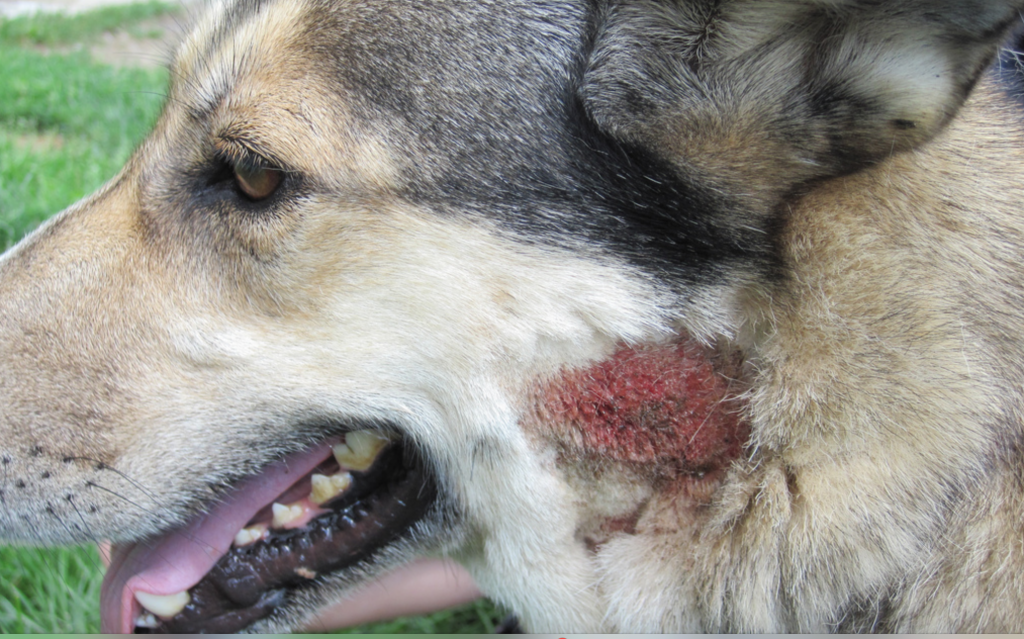
A MILD ANTISEPTIC SPRAY WILL HELP TREAT HOT SPOTS. YOUR VET CAN ALSO PROVIDE PRESCRIPTION PRODUCTS.
Dogs with allergies will often lick and scratch until they get “hot spots” like this one, which can be cleaned gently with a mild antiseptic spray.
How to Spot Dog Allergies
There are four main types of allergy in dogs: atopy, flea, food, and contact. Atopy refers to environmental allergies; a dog’s body releases excess histamine when exposed to higher concentrations of pollen in the air, which prompts symptoms. This article focuses mainly on environmental allergies. If you’re concerned about food allergies, talk to your vet, and try a limited-ingredient diet to determine which ingredients your dog might be reacting to.
The itching will likely start seasonally, which initially is how you can distinguish between atopy and other types of allergies. The most common signs of atopic allergies are:
- Itching
- Scratching
- Biting
- Chewing
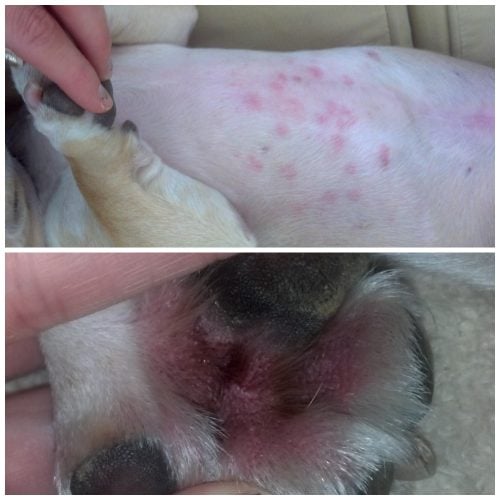
At-Home Treatment Options and Helpful Hints
You can help your allergic dog in a number of ways completely unrelated to drugs.
1.Wipe down your dog to remove allergens after walks

Pet grooming wipes are a quick way to remove dander and allergens when a full bath isn’t possible. We like the fragrance-free, hypoallergenic Pogi’s wipes.
2. Try a hypoallergenic shampoo
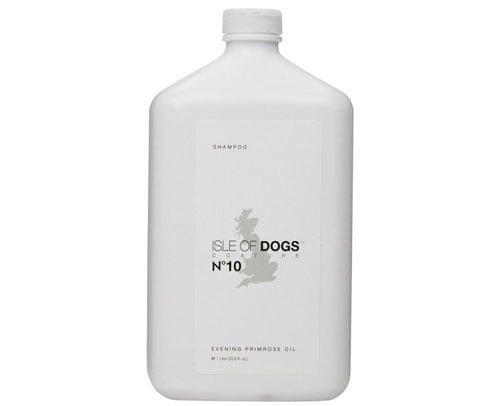
You can buy this and related anti-itch shampoo over-the-counter. Look for soothing ingredients like aloe, oatmeal, or evening primrose oil. That’s the main ingredient in this highly-rated choice.
3. Use supplements such as biotin or omega-3s

These help to suppress itching and improve coat health. Vet’s Best also offers well-regarded natural supplementsto combat seasonal allergies.
4. Try Sulfodene treatments
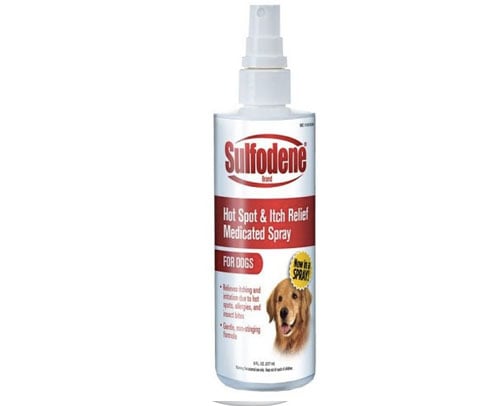
Sulfodene products use an FDA-approved formula for treating irritation, red skin, and hot spots in particular.
5. Give baths with a gentle or medicated shampoo

Baths help to control the amount of allergens on your dog’s skin, as long as avoid anything that will irritate or dry out their skin.
6. Apply a medicated spray
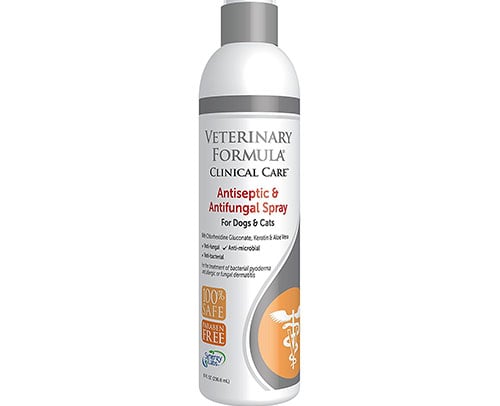
This popular choice from SynergyLabs helps treat fungal and bacterial skin infections, plus contains soothing aloe.
6. Use prescription shampoos or sprays
Available from your vet.
Getting Relief: Medical Treatment Options

Do you pop a Benadryl or Claritin when your allergies act up? The first way to get relief for your pet is the same—antihistamines!
You must consult your vet to determine which antihistamine is best and get specific dosage for your dog.
Unfortunately, antihistamines are only effective in 30% of dogs. While they may work for you at first, antihistamines often lose effectiveness.
“If an antihistamine is effective, you could carry that out as long as it lasts,” Dr. Eckholm explains. “Sometimes, you can manage allergies just with that. Other times, as allergies progress, antihistamines are no longer effective.”
The next option is a much stronger medication—corticosteroids. Steroids are much more effective at treating allergy symptoms but are not recommended for long-term use because of possible severe and permanent side effects. But don’t be hesitant to use steroids because of the stigma—they can be very effective even in small doses and can help give relief to an itchy pet.
“It’s about quality of life,” Dr. Eckholm reasons.
If you graduate to steroids, you should also pursue allergy testing at that time.
“Allergy testing and immunotherapy [allergy shots] are the gold standard for managing environmental allergies,” Dr. Eckholm says. “Allergy shots are the only effective method to stop the progression of allergies.”
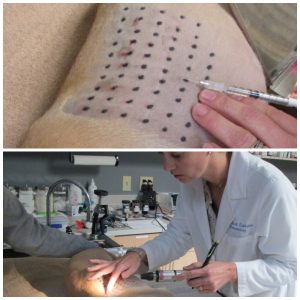
INTRA-DERMAL OR SKIN ALLERGY TESTING IS DONE BY INJECTING ALLERGENS INTO THE SKIN AND SEEING WHICH ONES THE DOG REACTS TO. DR. NICOLE ECKHOLM IS SEEN AT BOTTOM READING THE RESULTS OF YELLOW DOG.
Dogs are allergy tested much the same as humans; allergens are numbered and injected into the skin along with a positive and negative control. If the dog has a reaction, a hive or welt appears within 15 minutes of the injection. The vet administering the test will look at each hive and determine the degree of redness, which determines which allergens are the most significant. All of the allergens are then mixed together in various concentrations to formulate the allergy shot.
The concentration of the allergens in the shots will increase slowly over time in order to desensitize your pet’s immune system. It takes six to nine months to start seeing those results. Allergy shots have up to an 80% success rate and although a dog may not see 100% improvement, Dr. Eckholm still thinks it’s worth it to try the shots.
“If the dog is greater than 50% improved, it’s worth continuing the allergy shots,” Dr. Eckholm suggests. “Again, it’s about quality of life for your pet.”
If your dog does not respond well enough to immunotherapy, the final option is immune-suppressants (or immune modulators), which suppress the immune system so that it will not respond to harmless allergens. The two drugs on the market are Atopica and Apoquel, but both can cause side effects, mainly vomiting and diarrhea but also an increased risk of infection from having a weakened immune system.
Dr. Eckholm says the chosen treatment depends on each individual dog.
“Every dog is going to be affected differently,” Dr. Ekholm says. “So it just depends on response to treatment.”
The Benefits of Allergy Shots for Dogs
It’s important you seek immunotherapy treatment as soon as possible for your allergic pet for a number of reasons.
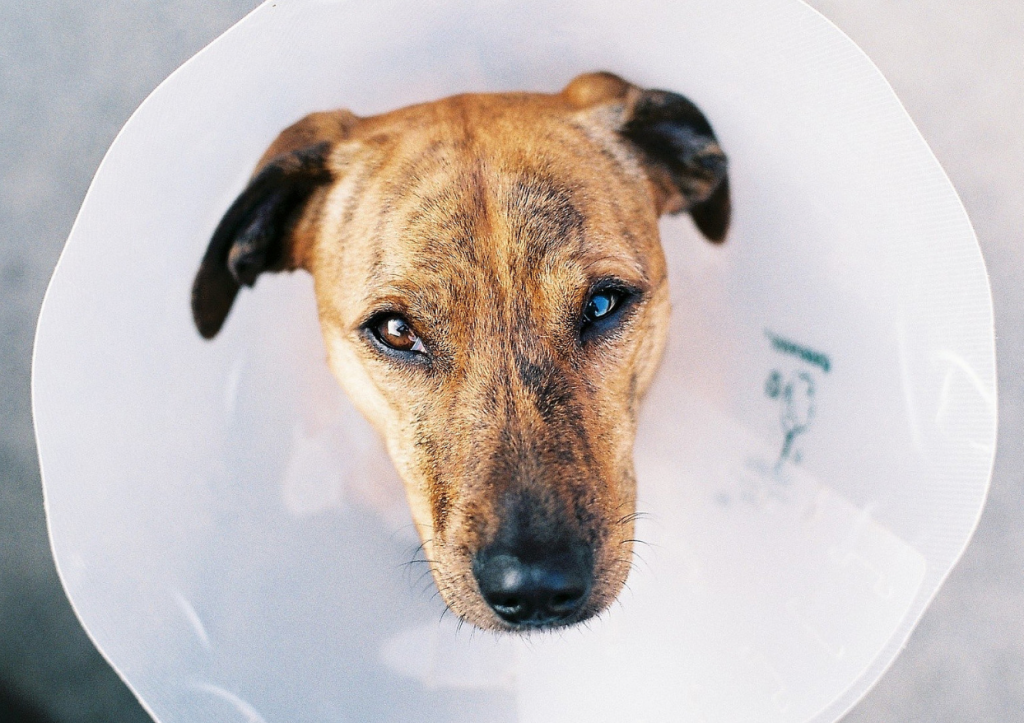
GETTING YOUR DOG SOME RELIEF FROM HIS ALLERGY ITCHES CAN LEAD TO A MUCH BETTER QUALITY OF LIFE. OTHERWISE, HE MIGHT HAVE TO LIVE HIS LIFE IN THE CONE, WHICH IS NO WAY TO LIVE AT ALL!
First, as previously mentioned, environmental allergies are progressive and will worsen as a dog gets older. Immunotherapy is much more successful in younger pets.
“The younger you allergy test a dog and start immunotherapy, the better they do,” Dr. Eckholm explains. “If a dog comes in as a senior, I don’t often recommend testing them because it’s not as effective.”
It’s also about quality of life for your pet. Just what does quality of life mean? Anyone with an allergic dog can tell you, relief from constant itching and scratching without having to keep your dog in a cone 24/7 is worth it! If you don’t cone your dog, you risk him developing painful hot spots from incessant licking. Who wants their dog to live like that?
Also, dogs will develop secondary bacterial infections as a result of their allergies. These are managed with antibiotics, which also become less effective over time.
“Secondary bacterial infections can become resistant with the repeated use of antibiotics, making it more difficult, and expensive, to treat these infections when they arise,” Dr. Eckholm says.
The Testing Process and Giving Shots
The intra-dermal testing process is actually quite easy—and not traumatic!—for you and your dog. The vet dermatologist will need to shave a 4 by 6 inch patch of hair on your dog to inject the allergens.
Your area vet dermatologist will inject the most common allergens in general, and the ones specific to the region where you live. Overall, they will test roughly 50 different items to get the best idea what your dog is reacting to.

DOG ALLERGY SHOTS ARE FORMULATED BY MIXING ALL THE ALLERGENS THEY REACTED TO IN A VIAL TO GIVE IN VARYING DOSES AS A SHOT.
Your dog will react within minutes with varying degrees of redness, or no reaction at all. Your dog’s allergy shot will be formulated based on the severity and number of reactions.
Depending on the severity of allergies, you will be required to give an allergy shot every other day for 30 days followed by once a week for a year. Maintenance will depend on your dog’s response.
For example, after a year of consistent shots, my dog only needs a shot every three to four weeks or so, which is very cost-effective to maintain.
If you are skittish about physically giving your dog an allergy shot, there is another option!
The alternative is sublingual immunotherapy under the tongue—SLIT for short—which is a pump you squeeze into their mouth.”About a third of people choose that route either because they’re afraid their dog will bite or they don’t want to do injections,” Dr. Eckholm says.
Who is at Risk
About ten perfect of all dogs develop environmental allergies. Some breeds are more susceptible, such as:
- Retrievers
- Terriers
- Boxers
- Dalmatians
- Bulldogs
- Shepherds
- Beagles
- Irish Setters
You cannot simply avoid the allergen, as you might read online, especially trees, grasses, and dust mites.
“They’re allergic to the pollen and that is carried in the air,” Dr. Eckholm explains. “It can be carried up to 30 miles in the air, and dust mites are everywhere.”
If your dog does develop allergies, he should not be bred.
The Bottom Line
Environmental allergies are on the rise. From trees and grasses to dust mites to even cats and cockroaches, there are a number of things your dog may be allergic to, which can cause him to be pretty miserable and develop infections without treatment. It’s worth it to see a dermatologist to try to give your pal a chance at a more comfortable life.
No comments:
Post a Comment